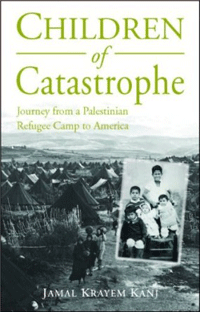
|
| Children of Catastrophe: Journey from a Palestinian Refugee Camp to America Written by Jamal Kanj Paperback: 192 pages, Garnet Publishing; 1st edition (October 15, 2010) |
Perhaps Palestinians living in Lebanon have had the most difficult experience. Restricted to camp life in a land where their mere existence constitutes a threat to a delicate sectarian balance, Palestinian refugees in Lebanon often reside in the most impoverished conditions when compared to those in other refugee camps. There is also the unique history of attacks on Palestinian refugee camps in Lebanon which have been severe and bloody in nature, and have not been rivaled in any other refugee camps in the Arab states. Tel al Zatar, Nabatia, Sabra and Shatila and most recently Nahr al-Bared, are all refugee camps in Lebanon whose occupants have witnessed destruction and dispossession again years after the depopulation of Palestine in 1948.
While most Palestinians can identify with the general refugee experience of dispossession, refugees in different camps and different host countries face different tragedies, challenges and histories. So what does it mean to be a Palestinian refugee from a camp in Lebanon like Nahr al-Bared, for example? Answers to this question can be found in the unique story told by Jamal Kanj in his recent and appropriately titled book, “Children of Catastrophe.”
Kanj, an engineer by training, takes the reader through a detailed, personal account of life in a Palestinian refugee camp in Lebanon. Often with meticulous (sometimes overly so) detail, the author focuses on the elements of refugee life which are hard to fathom for those unfamiliar with the density and poor conditions associated with camp life. The images of eight people sleeping on the floor of a small, crowded room, refugee children digging through scraps to sell for additional income, fishing using explosives in shark-infested waters and preteens sneaking into Syrian-based PLO training facilities only to be turned away are some of the heart-wrenching scenes which will remain in this reader’s mind for some time. There are no pictures in this book, but Kanj illustrates verbosely to describe vivid memories from his childhood.
The story evolves over time as Kanj takes us through his experiences and his eventual return to Palestine and occupied Jerusalem by way of San Diego, California and a near-death experience which became a twist of fate. He closes with a somber discussion of the destruction of his childhood home, the Nahr al-Bared refugee camp, in 2007 by the Lebanese Army and the experience his family endured becoming refugees from a refugee camp.
Kanj’s story is unique in that it is his personal experience, but it is at the same time one that most Palestinians can understand through their own experiences in a different camp, country or occupied village. It is, as Kanj puts it, an experience of dispossession which unites an “enduring nation in exile,” wherever they may be. For Palestinians and non-Palestinians alike, “Children of Catastrophe” offers an important glimpse into the refugee life most people would have difficulty imagining.
Yousef Munayyer is Executive Director of the Palestine Center, from where this review was taken.






Leave a Reply